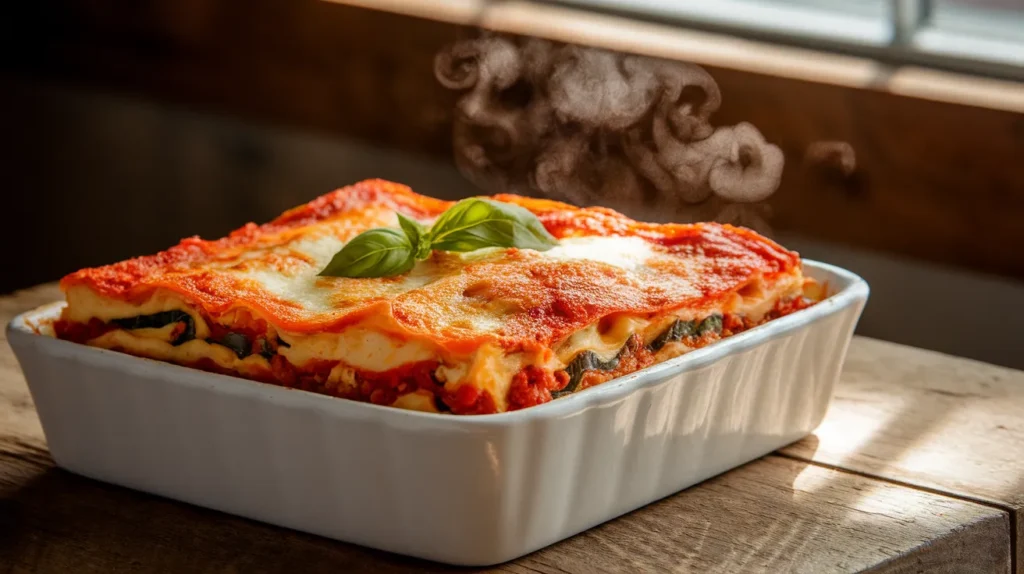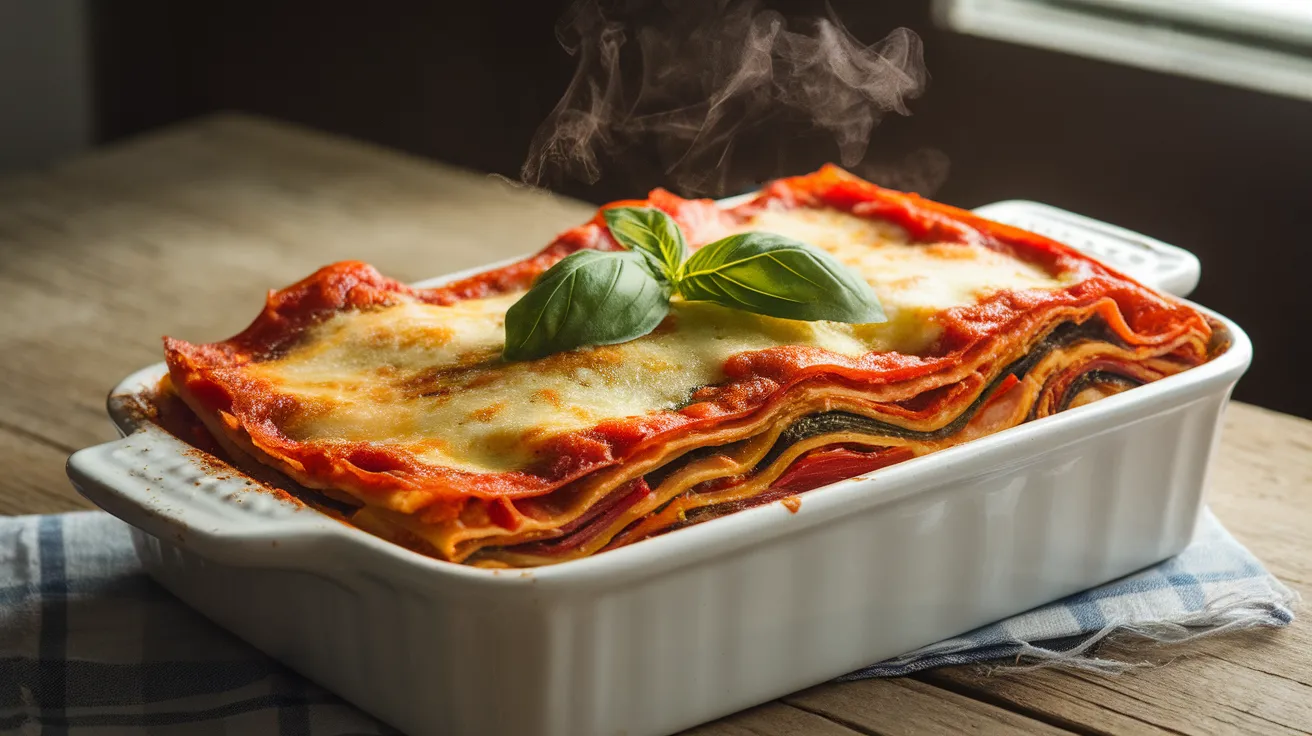This hearty vegan lasagna recipe transforms simple plant-based ingredients into layers of rich, satisfying comfort food that rivals any traditional version. With creamy cashew ricotta, robust marinara, and tender vegetables, this vegan lasagna recipe delivers all the flavors you crave while keeping things completely dairy-free and delicious.
SERVES: 4 | PREP: 20 MIN | COOK: 25 MIN | TOTAL: 45 MIN
Ingredients
For the Cashew Ricotta:
| Ingredient | Amount |
|---|---|
| Raw cashews (soaked) | 1½ cups |
| Lemon juice | 3 tablespoons |
| Nutritional yeast | ¼ cup |
| Garlic powder | 1 teaspoon |
| Salt | ½ teaspoon |
| Water | 2-3 tablespoons |
For the Veggie Layer:
| Ingredient | Amount |
|---|---|
| Zucchini, sliced thin | 1 medium |
| Bell peppers, diced | 1 cup |
| Spinach, fresh | 2 cups |
| Olive oil | 2 tablespoons |
Assembly Components:
| Ingredient | Amount |
|---|---|
| Marinara sauce | 2 cups |
| Lasagna noodles (no-boil) | 9 sheets |
| Vegan mozzarella, shredded | 1 cup |
| Fresh basil | ¼ cup chopped |
Complete Vegan Lasagna Recipe Instructions
Phase 1: Kitchen Setup and Prep Work (8 minutes)
1. Set up your workspace: Clear a clean, flat surface near your stove and oven. Gather all ingredients and equipment before starting. This vegan lasagna recipe moves quickly once you begin, so having everything ready prevents scrambling later.
2. Preheat your oven: Turn your oven to 375°F and let it fully preheat while you prep. This takes about 10-15 minutes in most ovens. Look for the indicator light to turn off, signaling it’s reached temperature.
3. Prepare your baking dish: Take your 9×13-inch baking dish and drizzle 1 teaspoon olive oil across the bottom. Use a paper towel to spread it evenly, coating all corners and sides about 1 inch up. This prevents sticking and makes cleanup much easier.
4. Drain the cashews: If you soaked cashews overnight, drain them in a fine-mesh strainer and rinse with cool water until the water runs clear. If you forgot to soak them, place cashews in a bowl and cover with boiling water. Let sit for 15 minutes, then drain and rinse.
5. Make the cashew ricotta: Add drained cashews to your food processor bowl. Add lemon juice, nutritional yeast, garlic powder, and salt. Put the lid on securely and process for 30 seconds. Stop and scrape down sides with a spatula. Add 2 tablespoons water and process again for 1 minute until smooth and creamy. The texture should look like traditional ricotta cheese – smooth but with tiny bits. If it’s too thick, add water 1 tablespoon at a time until perfect. Taste and add more salt if needed.
6. Prep all vegetables: Wash the zucchini and pat completely dry with paper towels. Using a sharp knife, slice into ¼-inch thick rounds. Don’t go thinner or they’ll get mushy. Wash and dice the bell pepper into ½-inch pieces – uniform size helps even cooking. Remove thick stems from spinach leaves and give them a final rinse.
Phase 2: Cooking the Vegetables (7 minutes)
7. Heat your skillet: Place a large skillet over medium heat and let it warm for 1 minute. Add 1 tablespoon olive oil and swirl to coat the bottom evenly. You’ll know it’s ready when the oil shimmers but doesn’t smoke.
8. Cook the bell peppers: Add diced bell peppers to the hot oil. You should hear a gentle sizzle – if it’s aggressive, lower the heat slightly. Stir every 30 seconds using a wooden spoon or spatula. Cook for 3-4 minutes total until peppers are bright in color and slightly softened but still have some crunch. Don’t overcook or they’ll become mushy in the lasagna.
9. Add the spinach: Push bell peppers to one side of the skillet. Add fresh spinach leaves to the empty space – they’ll seem like a lot but will shrink dramatically. Using tongs or a spatula, gently toss the spinach for 1-2 minutes until all leaves are wilted and dark green. The spinach should reduce to about ½ cup.
10. Season and set aside: Sprinkle the cooked vegetables with ¼ teaspoon salt and ⅛ teaspoon black pepper. Stir to combine, then remove from heat. Transfer to a plate and let cool for 3-4 minutes while you start assembly. This cooling prevents the vegetables from making your lasagna watery.
Phase 3: Building Your Vegan Lasagna Recipe Layers (8 minutes)
11. Start with sauce: Open your marinara sauce and give it a quick stir. Spread ½ cup sauce evenly across the bottom of your prepared baking dish using the back of a large spoon. Make sure you cover every inch of the bottom – this prevents the noodles from sticking and burning. The layer should be thin but complete.
12. First noodle layer: Take 3 no-boil lasagna sheets from the box. These are typically about 3×5 inches each. Lay them over the sauce in a single layer, with the long sides running the length of your dish. They should slightly overlap by about ½ inch – this is perfect. Don’t worry if they don’t cover every edge; they’ll expand during cooking.
13. First ricotta layer: Using a large spoon, dollop half the cashew ricotta (about ¾ cup) evenly over the noodles. Start with small spoonfuls and spread gently with the back of the spoon or an offset spatula. You want an even layer about ¼ inch thick. Take your time here – even layers cook more uniformly.
14. Add vegetables and cheese: Sprinkle half the cooked vegetables evenly over the ricotta layer. Use your fingers to distribute them well, ensuring each bite will have vegetables. Top with ⅓ cup vegan mozzarella, sprinkling it evenly across the surface.
15. Second sauce and noodle layer: Spoon ⅔ cup marinara sauce over the cheese, spreading gently to avoid disturbing the layers below. Place 3 more lasagna sheets on top, overlapping as before. The sauce will help them stick and cook properly.
16. Repeat the filling layers: Spread the remaining cashew ricotta over these noodles, then add the remaining cooked vegetables. Sprinkle with another ⅓ cup vegan mozzarella. You’re building identical layers, which ensures consistent flavor in every bite.
17. Final layer construction: Place the last 3 lasagna sheets on top. Spread the remaining marinara sauce evenly over these final noodles – use it all up. This top sauce layer is crucial for cooking the top noodles properly. Finish with the remaining ⅓ cup vegan mozzarella for that perfect golden top.
Phase 4: Baking Your Vegan Lasagna Recipe (25 minutes)
18. Cover for steaming: Tear off a piece of aluminum foil large enough to cover your dish with 2 inches extra on all sides. Lightly coat the underside with cooking spray or oil to prevent sticking to the cheese. Cover the dish tightly, crimping the edges to seal completely. This creates a steam chamber that cooks the no-boil noodles perfectly.
19. Initial baking: Place the covered dish on the center rack of your preheated oven. Set a timer for 20 minutes. During this time, the trapped steam will soften the noodles and meld all the flavors together. You might hear gentle bubbling – this is perfect.
20. Uncover for browning: After 20 minutes, carefully remove the foil – watch out for hot steam. The top should look set but pale. Return to the oven uncovered for 5 more minutes. The top will turn golden and you’ll see active bubbling around the edges.
21. Test for doneness: Insert a sharp knife through the center of the lasagna down to the bottom. It should slide through all layers easily without hitting any hard noodles. If you feel resistance, cover and bake 3-5 minutes longer.
22. Essential resting time: Remove from oven and let your vegan lasagna recipe rest on the counter for 8-10 minutes. This isn’t optional – the layers need time to set and the moisture needs to redistribute. Cover loosely with a clean kitchen towel to keep warm.
23. Garnish and serve: Just before serving, sprinkle fresh chopped basil over the top for color and fresh flavor. Using a sharp knife, cut into 4 equal portions. Wipe the knife clean between cuts for the neatest slices. Serve immediately while hot and bubbly.
Chef’s Notes for Perfect Vegan Lasagna Recipe
Cashew Soaking Shortcut: If you forgot to soak cashews overnight, cover them with boiling water for 15 minutes for quick softening. This vegan lasagna recipe works perfectly with this time-saving method.
Noodle Success: No-boil noodles need adequate moisture to cook properly. Make sure your sauce isn’t too thick, and don’t skip the foil covering during the first part of baking.
Make-Ahead Magic: Assemble this vegan lasagna recipe up to 24 hours ahead. Cover and refrigerate, then add 10 extra minutes to the covered baking time.
Texture Perfection: The zucchini adds moisture and nutrition without making the lasagna watery. Pat slices dry with paper towels if they seem very wet.
Nutrition Information (Per Serving)
- Calories: 485
- Protein: 18g
- Carbohydrates: 52g
- Fat: 24g
- Fiber: 8g
- Sodium: 680mg
Creative Vegan Lasagna Recipe Variations
Mediterranean Twist: Replace bell peppers with sun-dried tomatoes and kalamata olives. Add fresh oregano to the cashew ricotta for an authentic Mediterranean flavor profile.
Protein Power: Fold crumbled firm tofu or cooked lentils into your vegetable layer. This creates an even heartier version that pairs beautifully with vegan mac and cheese for a comfort food feast.
Mushroom Lovers: Sauté sliced mushrooms with garlic until golden. Layer them with the other vegetables for an earthy, umami-rich variation.
Holiday Style: Add roasted butternut squash and sage to create a festive version that complements vegan green bean casserole perfectly for plant-based holiday meals.
Storage & Reheating
Refrigerator Storage: Cover leftover portions tightly and refrigerate for up to 4 days. The flavors actually improve after a day, making leftovers even more delicious.
Freezing Instructions: Wrap individual portions in plastic wrap, then aluminum foil. Freeze for up to 3 months. Thaw overnight in refrigerator before reheating.
Reheating Methods: For best results, reheat covered portions in a 325°F oven for 15-20 minutes. Microwave individual servings on 70% power for 2-3 minutes, checking frequently.
Crispy Top Trick: For reheated portions, finish under the broiler for 1-2 minutes to restore that golden, bubbly top texture.

Troubleshooting Your Vegan Lasagna Recipe
Problem: Watery lasagna Solution: Pat zucchini slices dry before layering, and ensure your marinara isn’t too thin. Let the finished lasagna rest for at least 8 minutes before cutting to allow excess moisture to absorb.
Problem: Dry, tough noodles Solution: Make sure you have enough sauce throughout all layers. No-boil noodles rely on moisture from sauce to cook properly. Cover tightly with foil during the first 20 minutes of baking.
Problem: Bland cashew ricotta Solution: Taste and adjust seasoning before assembly. Add more lemon juice for brightness, nutritional yeast for cheesy flavor, or salt for overall taste enhancement.
Problem: Uneven cooking Solution: Cut vegetables uniformly and layer evenly. Rotate the pan halfway through baking if your oven has hot spots.
Problem: Messy cutting Solution: Use a sharp knife and wipe it clean between cuts. Let the lasagna rest longer – up to 10 minutes for cleaner slices.
Equipment Essentials
- 9×13-inch baking dish (glass or ceramic preferred)
- Food processor for smooth cashew ricotta
- Large skillet for sautéing vegetables
- Sharp knife for clean vegetable cuts
- Measuring cups and spoons
- Aluminum foil for covering during baking
- Rubber spatula for even spreading
Shopping List
Produce Section:
- Raw cashews (1½ cups)
- Fresh lemon (for 3 tbsp juice)
- Zucchini (1 medium)
- Bell peppers (1 large)
- Fresh spinach (2 cups)
- Fresh basil (1 bunch)
Pantry Items:
- Nutritional yeast (¼ cup)
- Olive oil
- Garlic powder
- Salt and pepper
- Marinara sauce (2 cups)
Pasta Aisle:
- No-boil lasagna noodles (1 box)
Refrigerated Section:
- Vegan mozzarella cheese (1 cup shredded)
Success Secrets
1. Soak cashews overnight: This creates the creamiest ricotta texture possible. Room temperature water works fine – no need for hot water.
2. Don’t skip the rest time: Letting your vegan lasagna recipe sit for 8-10 minutes after baking is crucial for clean cuts and proper layer setting.
3. Layer sauce generously: No-boil noodles absorb lots of moisture, so don’t be stingy with the marinara between layers.
4. Test doneness properly: Insert a knife through all layers – it should slide through easily without resistance from hard noodles.
5. Make it your own: This base recipe welcomes creativity. Add your favorite vegetables, herbs, or plant-based proteins to customize each batch.
This foolproof vegan lasagna recipe proves that plant-based comfort food can be just as satisfying as traditional versions. With simple techniques and quality ingredients, you’ll create layers of flavor that please vegans and omnivores alike. The combination of creamy cashew ricotta, perfectly seasoned vegetables, and robust marinara creates a memorable meal that’s perfect for family dinners or entertaining guests. Whether you’re new to plant-based cooking or a seasoned pro, this vegan lasagna recipe delivers consistent, delicious results every time.




